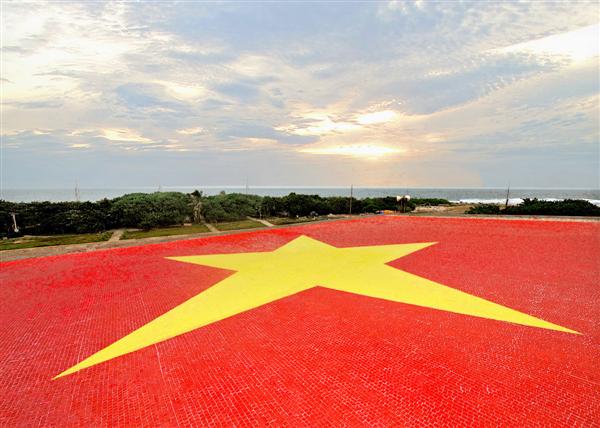yusheng
FULL MEMBER

- Joined
- Sep 15, 2007
- Messages
- 1,672
- Reaction score
- 6
The Chinese Solution For The South China Sea
"chinese rural dog" for SCS
March 11, 2013: Last August the Chinese Navy received its first Type 056 corvette. After extensive testing at sea, this ship (hull number 582) entered service on February 24th. There are at least twenty more 056s under construction and 4-5 more will enter service this year. These ships appear to be playing a crucial role in Chinese efforts to seize control of the South China Sea.

The Type 056s are 1,400 ton ships armed with four C-903 anti-ship missiles (200 kilometers range), a FL-3000N anti-aircraft missile (nine kilometers range) launcher (with eight missiles), two 30mm remotely controlled autocannon and one 76mm gun. The ship has air and sea search radars plus a helicopter platform in the rear and will be used mainly for coastal patrol. The ship is highly automated and has a crew of only 60.

The 056s will replace an aging fleet of Type 053 class frigates. It was one of these ships (the Dongguan) that ran aground on a reef off the Philippines coast near Half Moon Shoal two years ago. This happened 111 kilometers from the Philippines (Palawan Island) and over 1,100 kilometers from the Chinese mainland. Letting a 2,400 ton warship (carrying a crew of 200) move around in these shallow and treacherous waters at night was asking for trouble. The waters west of the Philippines (including all the reefs, shoals, atolls, and islets claimed by China) are shallow and full of obstacles just under the water. Even shallow draft fishing boats proceed carefully and usually just in daylight. GPS and recent efforts to fully map (chart) the area have made it safer but only for those who proceed with care. China eventually got the Dongguan off the reef. A Type 056, which has a shallower draft and more modern navigation systems, would probably not have gone aground in the first place.
China recently upgraded the Dongguan and the other five Type 053H1G frigates, apparently in order keep them in service for another decade or more. Originally built in the 1990s, the six Type 053H1G ships were the last of 53 Type 053s built over about twenty years. Based on the older Russian Riga class frigate, the Chinese expanded the original 1,400 ton Riga (armed with depth charges, three 100mm guns, and torpedoes) design, to a missile laden 2,500 ton vessel equipped with modern electronics. The few Type 053s still in service are mainly used for coastal patrol. But the 053 design grew too large for this job, and the smaller Type 056 sets that right.



"chinese rural dog" for SCS
March 11, 2013: Last August the Chinese Navy received its first Type 056 corvette. After extensive testing at sea, this ship (hull number 582) entered service on February 24th. There are at least twenty more 056s under construction and 4-5 more will enter service this year. These ships appear to be playing a crucial role in Chinese efforts to seize control of the South China Sea.

The Type 056s are 1,400 ton ships armed with four C-903 anti-ship missiles (200 kilometers range), a FL-3000N anti-aircraft missile (nine kilometers range) launcher (with eight missiles), two 30mm remotely controlled autocannon and one 76mm gun. The ship has air and sea search radars plus a helicopter platform in the rear and will be used mainly for coastal patrol. The ship is highly automated and has a crew of only 60.

The 056s will replace an aging fleet of Type 053 class frigates. It was one of these ships (the Dongguan) that ran aground on a reef off the Philippines coast near Half Moon Shoal two years ago. This happened 111 kilometers from the Philippines (Palawan Island) and over 1,100 kilometers from the Chinese mainland. Letting a 2,400 ton warship (carrying a crew of 200) move around in these shallow and treacherous waters at night was asking for trouble. The waters west of the Philippines (including all the reefs, shoals, atolls, and islets claimed by China) are shallow and full of obstacles just under the water. Even shallow draft fishing boats proceed carefully and usually just in daylight. GPS and recent efforts to fully map (chart) the area have made it safer but only for those who proceed with care. China eventually got the Dongguan off the reef. A Type 056, which has a shallower draft and more modern navigation systems, would probably not have gone aground in the first place.
China recently upgraded the Dongguan and the other five Type 053H1G frigates, apparently in order keep them in service for another decade or more. Originally built in the 1990s, the six Type 053H1G ships were the last of 53 Type 053s built over about twenty years. Based on the older Russian Riga class frigate, the Chinese expanded the original 1,400 ton Riga (armed with depth charges, three 100mm guns, and torpedoes) design, to a missile laden 2,500 ton vessel equipped with modern electronics. The few Type 053s still in service are mainly used for coastal patrol. But the 053 design grew too large for this job, and the smaller Type 056 sets that right.







 .
.









